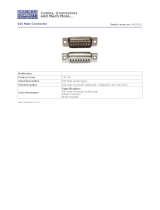
Turbo PMAC2 VME Ultralite
Table of Contents i
Table of Contents
INTRODUCTION.....................................................................................................................................................1
Board Configuration................................................................................................................................................1
Base Version.......................................................................................................................................................1
MACRO Ring Connector Options ......................................................................................................................1
Option 1: Additional MACRO Interface Ics......................................................................................................2
Option 2: Dual-Ported RAM .............................................................................................................................2
Option 5: CPU and Memory Configurations ....................................................................................................2
Option 7: Plate Mounting..................................................................................................................................3
Option 8: High-Accuracy Clock Crystal ...........................................................................................................3
Option 9: Auxiliary Serial Port .........................................................................................................................3
Option 10: Firmware Version Specification......................................................................................................3
Option 16A: Battery-Backed Parameter Memory.............................................................................................3
Option 18A: Electronic Identification ...............................................................................................................3
JUMPER DESCRIPTION........................................................................................................................................5
E0: Reset Lock Enable...........................................................................................................................................6
E1: Card 0 (Clock Direction) Select.......................................................................................................................6
E2: 40/60 MHz Operation......................................................................................................................................6
E3: Re-Initialization on Reset Control...................................................................................................................6
E4-E6: (Reserved for Future Use)..........................................................................................................................6
E10A, B, C: Flash Memory Bank Select.................................................................................................................6
E17 – E18: Serial Port Select.................................................................................................................................7
E19: Watchdog Disable Jumper..............................................................................................................................7
E20 – E22: Power-Up/Reset Load Source..............................................................................................................7
E23: Firmware Reload Enable ................................................................................................................................7
E40: Electrical/Optical MACRO Input Select ........................................................................................................7
SOFTWARE SETUP ................................................................................................................................................9
PMAC I-Variables ..................................................................................................................................................9
MATING CONNECTORS.....................................................................................................................................11
J1: JTAG/OnCE (for Factory Use Only): 10-pin IDC Header.......................................................................11
J2 (JTHW)/Multiplexer Port.............................................................................................................................11
J3 (JIO)/Digital I/O..........................................................................................................................................11
J5 (JRS232)/RS-232 Serial Communications...................................................................................................11
J5A (JRS422)/RS-422 Serial Communications.................................................................................................11
J6 (JDISP)/Display...........................................................................................................................................11
J7 (JHW)/Auxiliary Channel ............................................................................................................................11
J9: JISP (for Factory Use Only): 8-pin SIP Connector ..................................................................................11
J11 (JEXP)/Expansion......................................................................................................................................11
J14: MACRO Electrical Input Connector: 8-pin RJ-45 Socket.......................................................................11
J17: MACRO Electrical Output Connector: 8-pin RJ-45 Socket....................................................................11
P1: VME Bus 3U Connector ............................................................................................................................11
P2: VME Bus 3U Connector ............................................................................................................................11
TB1: JPWR Power Supply Connector: 2-point Terminal Block......................................................................11
TB2: WD Watchdog Output Connector: 4-point Terminal Block ...................................................................11
U4: MACRO Fiber Optic Transceiver: Double SC Fiber-Optic Socket .........................................................11
CONNECTOR PINOUTS ......................................................................................................................................13
J2 (JTHW) Multiplexer Port Connector................................................................................................................13
J3 (JI/O) General Input/Output Connector............................................................................................................14
J3/JIO (40-Pin Header)....................................................................................................................................14
J5 (JRS232) Serial Port Connector........................................................................................................................15
J5/JRS232 (10-Pin Header)..............................................................................................................................15





















